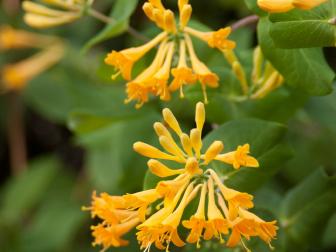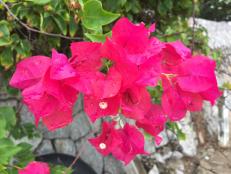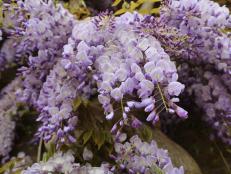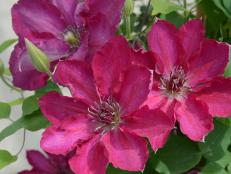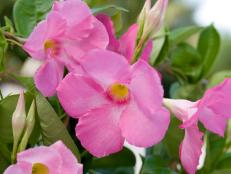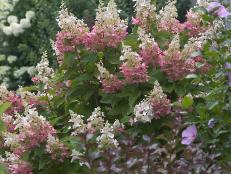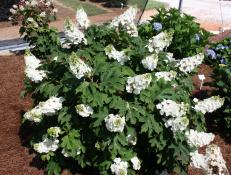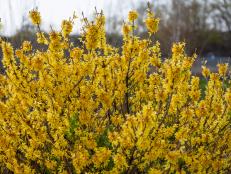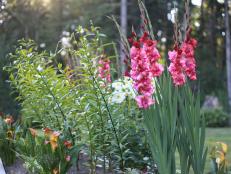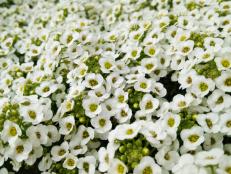How to Choose and Grow Honeysuckle
Few garden plants are as polarizing for gardeners as the honeysuckle. Honeysuckle flowers can be a welcome sight in the garden or a headache for gardeners, depending on location and perspective.

Shutterstock/Pictures_for_You
There are plenty of worthy honeysuckle plant varieties, such as Lonicera albiflora, that deserve a place in the garden, whether it be for their flowers, fragrance, foliage or wildlife value.

Nothing says "spring" quite like the sweet smell of honeysuckle flowers drifting in the breeze. While most of the honeysuckle species that grow wild through the US are invasive exotics that can wreak havoc on natural ecosystems, there are some beautiful native flowering honeysuckles as well as well-behaved non-natives that make a great addition to any garden.
Botanical Name: Lonicera spp.
Common Name: Honeysuckle
Bloom Time: Spring
Light Needs: Full sun to part shade
Hardiness Zones: 4 to 9, depending on the species
Height: Up to 20 feet, depending on the species
Growth Rate: Fast
The Best Vines to Grow on Arches and Pergolas 12 Photos
Give your yard picturesque beauty by draping structures with beautiful, easy-growing vines. And yes, honeysuckle made the list.
Why are Some Honeysuckles a Problem?
Many vining or shrubby honeysuckles that are gorgeous in bloom and tolerant of a wide range of growing conditions were widely planted in the last century as flowering ornamentals, to provide food and habitat for wildlife and in an effort to reduce soil erosion. Unfortunately, because birds eat the fruits and new plants grow readily from seed, these species quickly escaped cultivation and spread rapidly in natural areas where they displace native plants.
Problems for Birds
One might think that the problem isn’t so serious, so long as troublesome invasive honeysuckles are benefiting our beloved songbirds. Unfortunately, the problem is more complicated.
While birds do eat honeysuckle berries, the carbohydrate-rich fruits are the nutritional equivalent of angel food cake for our avian friends, who need a high-fat diet that berry-producing native plants provide. Many berries produced by native, fall-fruiting plants range somewhere between 30% and 50% fat content, which helps birds either overwinter in cold climates or fuels migrating birds for their long journeys. In contrast, Amur honeysuckle (L. maackii) fruits only contain between 3% and 4% fat. When invasive honeysuckles displace native plant species, there are fewer healthy, high-fat berries available, with potentially serious health consequences for local bird populations.
Many birds do enjoy berries — especially during fall migration and over the winter — however, bugs are also an incredibly important food source. Entomologist Dr. Douglas Tallamy describes this relationship in detail in his book Bringing Nature Home. Insects are a fantastic source of protein that mother birds need to make strong, healthy eggs. Soft-bodied bugs like caterpillars and sawflies are easily digestible by baby birds (which can’t eat birdseed or berries) in the spring.
Indigenous plants and animals — especially insects — developed complex relationships over many thousands of years that have led some native plant species to support a diversity of insect herbivores, including butterfly and moth caterpillars. Many North American insects avoid eating exotic honeysuckles. In natural areas where native plants have been displaced by invasive species, there are fewer bugs for birds to eat and feed to their young.
Problems for Woodland Ecosystems
Honeysuckles are highly adaptable to many environmental conditions and tolerate full shade and many types of soil. When a bird drops a honeysuckle seed in the woods, the new plant is able to effectively compete with the surrounding vegetation for resources. Honeysuckles tend to leaf out much earlier in the spring than many indigenous species and hold on to their foliage later in the fall, which allows honeysuckle to compete well in full shade and intercept what little sun plants lower in the understory rely on to grow and survive. As a result, many forested areas around the country are now congested with one or more non-native species of honeysuckle.
Problems for People
Natural areas that are overgrown with invasive honeysuckles, like Amur honeysuckle (L. maackii), can become havens for ticks that are infected with pathogens harmful to humans. In their 2010 article "Invasive honeysuckle eradication reduces tick-borne disease risk by altering host dynamics," Dr. Brian Allen of Washington University’s Tyson Research Center and their coauthors found that dense stands of Amur honeysuckle (L. maackii) are associated with greater numbers of lone star ticks (Amblyomma americanum) that were infected with the zoonotic disease ehrlichiosis (Ehrlichia chaffeensis and E. ewingii).
Apparently white tail deer, a common host for lone star and other species of ticks, prefer to browse in areas dominated by invasive honeysuckle. White tail deer are also a reservoir for several diseases that can infect humans if a tick feeds on a deer, then on a person. Their study first compared forested areas around St. Louis, Missouri, with high proportions of native vegetation to those with heavy stands of Amur honeysuckle. They found that significantly more infected lone star ticks inhabited the areas that were densely vegetated with Amur honeysuckle. When Amur honeysuckle was removed from the forest understory, the number of infected lone star ticks in the study area significantly decreased.
Because of these and other reasons, many species of honeysuckle have been flagged as "invasive" species by the US and many state governments. A 1999 presidential executive order defines the term "invasive" as a species that is non-native to the ecosystem under consideration and whose introduction causes or is likely to cause economic or environmental harm or harm to human health. Unfortunately, this describes several species of honeysuckle that were once popular garden plants.
Native Honeysuckles for Your Garden
While a few species have definitely given honeysuckle a bad rap, there are plenty of worthy selections that deserve a place in the garden, whether it be for their flowers, fragrance, foliage or wildlife value.
There are dozens of native species of true honeysuckles (Lonicera) and their relatives. A few species are highlighted below. For a more comprehensive list, the Ladybird Johnson Wildflower Center has a fantastic Plant Finder online database.
Bear in mind that the term "native" has more to do than the continent, country or state that a plant is endemic to. Introducing a species to your garden that is indigenous to one area of the US but from a different ecoregion has the potential to be more ecologically problematic than growing a non-native species that has proven to be well-behaved in your area. Just like the honeysuckles listed in the sections above, any plant, regardless of its provenance, has the potential to escape cultivation and naturalize in undesired areas. However, at the time of writing, none of the honeysuckle species that are endemic to North America is listed as an invasive species.
Western white honeysuckle (L. albiflora) is a shrubby, occasionally vining shrub that is native to the American Southwest. This species grows somewhere between 4 and 10 feet in height, with graceful, arching stems. Branches will be covered in showy white flowers in the spring that lack the fragrance of many other species of honeysuckle. Hardy in Zones 7 to 10.
Coral honeysuckle (L. sempervirens) is a vigorous vine that will quickly scramble over structures like arbors, fences and trellises. However, it’s less aggressive in the garden than some other native vines like trumpet creeper (Campsis radicans) or American wisteria (Wisteria frutescens). This species is absolutely stunning in the spring when in bloom. Flowers are an eye-catching coral with a golden interior that hummingbirds can’t resist. While the blooms lack the fragrance of other honeysuckles, this species more than makes up for that shortcoming in flower power and wildlife value. This is a must-have species for hummingbird lovers and can be combined with early blooming crossvine (Bignonia capreolata) and late blooming trumpet creeper to provide plenty of nectar through the season. This species is native from Nebraska to the east coast, north to Connecticut and south to Florida and hardy in Zones (3)4 to 9.
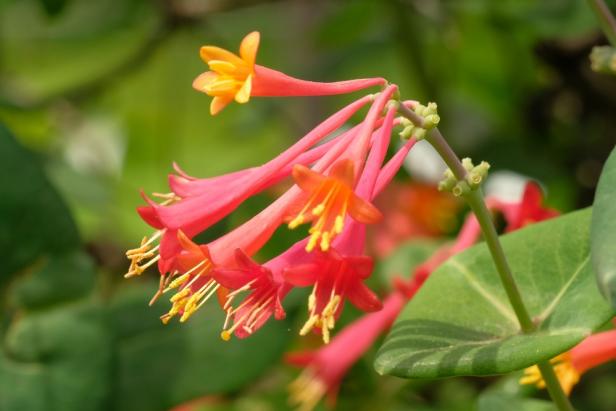
Shutterstock/shepherdsatellite
Lonicera sempervirens features flowers in an eye-catching coral with a golden interior that hummingbirds can’t resist.
Yellow honeysuckle (L. flava) is also a vining honeysuckle, although much less vigorous than coral honeysuckle. As the name suggests, the spring blooms come in shades of yellow, from pale blonde to orange, depending on the individual. Unlike coral honeysuckle, the flowers of this species can have a light fragrance. Native from North Carolina to Oklahoma. Hardy in Zones 5 to 8.
Dwarf bush honeysuckle (Diervilla lonicera), while not a true honeysuckle in the genus Lonicera, is a close relative with some similarities. This shrubby plant grows to 3 feet in height and slowly spreads in width thanks to colonizing roots. Cheerful golden flowers shine out in the summer garden. The cultivar ‘Copper’ produces attractive, coppery new growth that contrasts against the dark green mature foliage. Hardy in Zones 3 to 7.
Southern bush honeysuckle (D. sessifolia) grows slightly larger than D. lonicera, usually between 3 and 5 feet in height with a continuous spread. The foliage tends to be showier than the flower, with some colorful cultivars available. Hardy in Zones 4 to 7.
Other Well-Behaved Honeysuckles
Goldflame honeysuckle (L. x heckrottii) is a hybrid of unclear parentage, possibly between coral honeysuckle (L. sempervirens) and American woodbine (L. x americana, which may actually be a hybrid between two European species). In his Manual of Woody Landscape Plants, Dr. Michael Dirr writes this selection is "among the most handsome of the climbing honeysuckles." Deep magenta buds open to a saffron gold before fading to soft pink. The flowers are slightly fragrant, and the plants develop vigorous vines that quickly ramble up arbors, fences, trellises and other structures. Hardy in Zones (4)5 to 8(9).
Boxleaf honeysuckle (L. ligustrina var. yunnanensis, formerly L. nitida) is valued more for its dense and sometimes colorful foliage than for its flowers. This species usually grows to about 5 feet tall, although the variety ‘Twiggy’ maxes out at 3 feet in height. Boxleaf honeysuckle makes a great alternative to boxwood (Buxus sempervirens), forming an impenetrable hedge cloaked in little 1/4-inch-long leaves. Depending on the cultivar, the foliage color can be a rich green, lemony yellow (as in ‘Baggensen’s Gold’), or variegated white (‘Silver Cloud’). This species is native to Yunnan, China and is hardy in Zones 7 to 9.
Woodbine (L. periclymenum) has escaped cultivation in a few small areas in the Pacific Northwest, but it is not listed as an invasive in most of the US. This vining honeysuckle produces fragrant, colorful pink-yellow blooms. This species is native to much of western Europe, south to northern Africa. Hardy in Zones 4 to 8.
Planting Honeysuckle
Where to Plant Honeysuckle
Most honeysuckles grow well in part shade, but they flower better in full sun conditions with six or more hours of direct sunlight a day. Many species of Lonicera are adaptable to a wide range of conditions but most will grow better in rich soil that is moist and well-drained. Honeysuckles don’t usually tolerate "wet feet," so avoid planting in a soggy, poorly drained area. However, many species can tolerate lean, dry soils, too.
How to Plant Honeysuckle
Ornamental honeysuckles are usually grown from nursery-grown container plants. Dig a hole slightly larger than the size of the container, remove the root ball from the pot, place the root ball in the hole, cover with soil, then water well.
When to Plant Honeysuckle
When is the best time to plant honeysuckle? Like many woody shrubs or vines, honeysuckle does best in the long-term when planted in cool fall or spring weather.
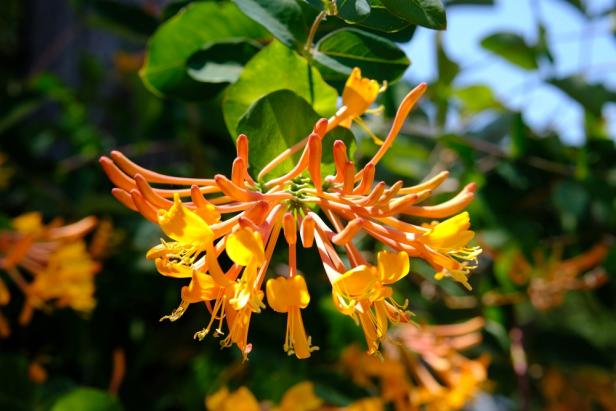
Shutterstock/nomis_h
Honeysuckle Lonicera flava is hardy in Zones 5 to 8.
Caring for Honeysuckle
Pruning Honeysuckle
Whether you’re growing a vining or shrubby honeysuckle, the pruning needs are largely the same. Honeysuckles usually have brittle stems that are prone to breakage or cold damage. While you can trim out any dead, diseased or damaged limbs at any time, the occasional heavy pruning can help breathe new life into an old, tired specimen.
Honeysuckles tend to grow vigorously from their roots, which means they can be cut back hard — 6 to 12 inches above the soil line, depending on the type — and quickly rebound. Shrub honeysuckles that start to look loose or scraggly can be cut back to about a foot above the ground after flowering to rejuvenate their appearance. Vining honeysuckles can be trimmed lightly as needed for shaping or cut back hard to revitalize old plants.
Training Honeysuckle
Vining honeysuckles naturally climb objects by twining their stems around them. Young plants may need some help finding their way toward an arbor or trellis. Use some jute string or plant ties to attach the vine to the structure. It may take a few months or even a full season, but eventually honeysuckle will happily clamber up and over.
Honeysuckle has an easier time attaching to supports that are the diameter of a broomstick or smaller. If you’d like honeysuckle to grow onto a tree, it will have trouble climbing into a medium or large tree without help. Provide a stake or string for the honeysuckle to follow until it reaches smaller branches higher in the canopy.
Honeysuckles to Avoid
Some plant species can potentially cause environmental or economic damage outside of their native ecoregion. While plant nurseries are discouraged from selling invasive species, it’s not always safe to assume that plants in your local garden center aren’t invasive in your region.
Species that have escaped cultivation in one part of the country may not necessarily have invasive qualities in other areas. To learn if any of the following species are invasive in your area, do a quick search at www.invasive.org or reach out to your state or county extension service for guidance. The list below highlights a selection of honeysuckle species that are listed as invasive in some areas of the U.S.
Winter honeysuckle (L. fragrantissima) is a multi-stemmed shrub that grows between 6 and 10 feet tall and has creamy white flowers with a lemony fragrance. This species is well-behaved in some areas of the country but an aggressive spreader in other regions — especially many eastern states.
Japanese honeysuckle (L. japonica) is a vining plant with intoxicatingly fragrant white-pink flowers that mature to yellow. This twining honeysuckle vine runs rampant through the understory of many natural areas across the continent, outcompeting and shading indigenous species.
Amur honeysuckle (L. maackii) will be familiar to gardeners across the eastern US, where it grows in a wide variety of habitats. This honeysuckle bush quickly grows to a 15' multi-stemmed shrub. Its white blooms mature to yellow with the classic and familiar "honeysuckle" fragrance. Where this species has escaped cultivation, it forms dense stands in open fields, woodland edges and in the understory, crowding out many types of native plants.
Morrow’s honeysuckle (L. morrowii) is another shrub honeysuckle that has "jumped the garden fence" in many areas of the country. This species grows up to 8 feet high and, like Amur honeysuckle, aggressively outcompetes indigenous flora in a variety of habitats, including open fields, woodlands, edges and the forest understory.
Tatarian honeysuckle (L. tatarica) forms a multi-stemmed shrub that grows up to 12 feet tall and heavily produces fragrant, pink or white flowers. This species has escaped cultivation and spread through natural areas in many northern and eastern states.
Bell’s honeysuckle (L. x bella) also called "showy fly honeysuckle" is a hybrid between Morrow’s and Tatarian honeysuckle. It grows as a shrub that can reach up to 20 feet in height and has fragrant, pink flowers that fade to yellow. Bell’s honeysuckle has escaped cultivation in several northern and eastern states.
Managing Invasive Honeysuckle Species
To control invasive or aggressive species of honeysuckle in a garden setting, it’s best to remove the entire plant, including the roots. Lift small plants with a trowel or shovel. Larger plants may require a tree puller or weed wrench that can remove more of the roots from the soil. Many honeysuckle species sprout readily from root fragments, so plan to revisit periodically to pull any new sprouts.
Unwanted honeysuckles frequently pop up from the center of other garden plants. This happens when birds eat honeysuckle fruit, then leave the seeds behind while perching in a shrub. If left unmanaged, the honeysuckle can slowly overtake and even replace the original shrub.
Honeysuckle seedlings growing under other plants are hard to spot, and mature honeysuckle is difficult to remove without damaging other shrubs. The best course of action in this situation is to use loppers to sever the stem at the soil line, although it takes several years to kill a honeysuckle plant by simply cutting at the ground. Another option is to use loppers to cut just above the soil line, then immediately paint the severed stem with a brush killing herbicide. Of course, follow all directions and safety precautions outlined on the product label.
If you want to manage invasive honeysuckle species in a natural area, coordinate with the property owner and seek guidance from experts with your local extension service. While completely removing noxious honeysuckle plants from heavily disturbed areas may seem like a good thing, if handled incorrectly this can lead to soil erosion, loss of riparian buffer along waterways and further ecosystem disturbance.






